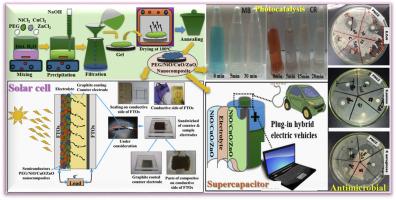In-situ synthesis of polyethylene glycol-assisted combined semiconductor metallic oxides nanocomposite for solar cell, supercapacitor, photocatalytic, and antibacterial applications
IF 5.6
2区 材料科学
Q1 MATERIALS SCIENCE, CERAMICS
引用次数: 0
Abstract
The rapid development of industries and populations causes environmental and energy related critical issues worldwide. Regarding energy crisis and environmental pollution, electrochemical energy storage, solar energy production, and photocatalysis/antibacterial activity are the utmost attractive strategies for the sustainable environment and energy industry. In this work, we synthesized ternary metallic oxide semiconductor structures PEG/NiO/CuO/ZnO (PNCZ) using polyethylene glycol as a capping agent in a sol-gel approach. The optical/structural properties of prepared nanocomposites were studied in detail using UV–vis and XRD/FT-IR analysis. The thermodynamic parameters were calculated using a TGA-DSC analysis. The prepared PNCZ nanocomposite displays 97 % and 99 % photocatalytic degradation of congo red (CR) and methylene blue (MB) dyes. The PNCZ composite also has good reusability for up to six cycles for CR dye. The prepared PNCZ nanocomposite positively responded against S. aureus, P. aeruginosa, and E. coli microbes with Zone of inhibition (ZOI) 2.9 cm, 1.8 cm, and 2.1 cm at 60 μL dosage. The PNCZ shows an extensive specific capacity of 3574 Cg-1 at 1 A g−1 and delivers a high specific energy of 75.52 Wh Kg−1 at a specific power of 65 W kg−1 with a capacitive retention of 96.5 % after 5000 cycles. PNCZ solar cell fabricated showed the highest efficiency of 7.4 % with VOC of 10 V, JSC of 8.24 mAcm−2, and FF of 0.74 %. Our present finding proposes designing and fabricating more efficient composite materials for energy (supercapacitor, solar cells) and environmental (photocatalysis, antimicrobial agent) applications.

原位合成聚乙二醇辅助组合半导体金属氧化物纳米复合材料,用于太阳能电池、超级电容器、光催化和抗菌应用
工业和人口的快速发展在世界范围内引起了与环境和能源相关的重大问题。面对能源危机和环境污染,电化学储能、太阳能生产和光催化/抗菌活性是可持续环境和能源产业最具吸引力的战略。本文以聚乙二醇为封盖剂,采用溶胶-凝胶法合成了PEG/NiO/CuO/ZnO (PNCZ)三元金属氧化物半导体结构。利用UV-vis和XRD/FT-IR分析对制备的纳米复合材料的光学/结构性能进行了详细的研究。利用热重-差热分析计算了热力学参数。制备的PNCZ纳米复合材料对刚果红(CR)和亚甲基蓝(MB)染料的光催化降解率分别为97%和99%。PNCZ复合材料对CR染料也具有良好的可重复使用性,最多可重复使用6次。制备的PNCZ纳米复合材料在60 μL剂量下对金黄色葡萄球菌、铜绿假单胞菌和大肠杆菌的抑制区(ZOI)分别为2.9 cm、1.8 cm和2.1 cm。PNCZ在1 A g−1时具有3574 Cg-1的宽比容量,在65 W Kg−1的比功率下具有75.52 Wh Kg−1的高比能量,在5000次循环后电容保持率为96.5%。制备的PNCZ太阳能电池在VOC为10 V、JSC为8.24 mAcm−2、FF为0.74%时效率最高,为7.4%。我们目前的发现建议设计和制造更高效的复合材料,用于能源(超级电容器,太阳能电池)和环境(光催化,抗菌剂)应用。
本文章由计算机程序翻译,如有差异,请以英文原文为准。
求助全文
约1分钟内获得全文
求助全文
来源期刊

Ceramics International
工程技术-材料科学:硅酸盐
CiteScore
9.40
自引率
15.40%
发文量
4558
审稿时长
25 days
期刊介绍:
Ceramics International covers the science of advanced ceramic materials. The journal encourages contributions that demonstrate how an understanding of the basic chemical and physical phenomena may direct materials design and stimulate ideas for new or improved processing techniques, in order to obtain materials with desired structural features and properties.
Ceramics International covers oxide and non-oxide ceramics, functional glasses, glass ceramics, amorphous inorganic non-metallic materials (and their combinations with metal and organic materials), in the form of particulates, dense or porous bodies, thin/thick films and laminated, graded and composite structures. Process related topics such as ceramic-ceramic joints or joining ceramics with dissimilar materials, as well as surface finishing and conditioning are also covered. Besides traditional processing techniques, manufacturing routes of interest include innovative procedures benefiting from externally applied stresses, electromagnetic fields and energetic beams, as well as top-down and self-assembly nanotechnology approaches. In addition, the journal welcomes submissions on bio-inspired and bio-enabled materials designs, experimentally validated multi scale modelling and simulation for materials design, and the use of the most advanced chemical and physical characterization techniques of structure, properties and behaviour.
Technologically relevant low-dimensional systems are a particular focus of Ceramics International. These include 0, 1 and 2-D nanomaterials (also covering CNTs, graphene and related materials, and diamond-like carbons), their nanocomposites, as well as nano-hybrids and hierarchical multifunctional nanostructures that might integrate molecular, biological and electronic components.
 求助内容:
求助内容: 应助结果提醒方式:
应助结果提醒方式:


